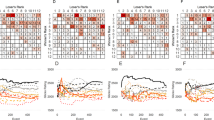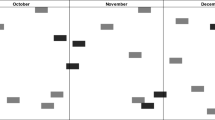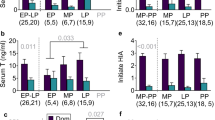Abstract
IT is axiomatic that the social structure of a group of primates has a pervasive effect on each individual's behaviour. Thus, many monkeys form dominance hierarchies, based on the successful outcome of aggressive interactions, and the more subordinate animals show characteristic behavioural traits1,2. In particular, the social hierarchy has marked effects on reproductive behaviour, especially in talapoin monkeys, where sexual interactions tend to be the prerogative of the dominant males3. Subordinate male rhesus monkeys have limited access to sexually attractive females and produce fewer offspring4, and in the few species that have been carefully examined, subordinate females, although apparently receiving sexual attention, are, nevertheless, less fertile than would be expected5–7. Recently, it has become clear that the dominance hierarchy affects not only behaviour but also hormone levels. Testosterone is higher in dominant males8,9, cortisol and prolactin are raised in more subordinate animals10. We report here evidence that subordination can prevent the luteinising hormone (LH) surge which is normally induced by giving oestrogen to female monkeys, thus offering an explanation for reduced fertility and suggesting that this can be induced by behavioural interactions.
This is a preview of subscription content, access via your institution
Access options
Subscribe to this journal
Receive 51 print issues and online access
$199.00 per year
only $3.90 per issue
Buy this article
- Purchase on Springer Link
- Instant access to full article PDF
Prices may be subject to local taxes which are calculated during checkout
Similar content being viewed by others
References
Richards, S. M. Anim. Behav. 22, 914–930 (1974).
Deag, J. M. Anim. Behav. 25, 465–474 (1977).
Dixson, A. F. & Herbert, J. Horm. Behav. 8, 141–154 (1977).
Duvall, S. W., Bernstein, I. S. & Gordon, T. P. J. Reprod. Fert. 47, 25–31 (19XX).
Drickhamer, L. C. Folia. Primatol. 21, 61–80 (1974).
Dunbar, R. I. M. & Dunbar, E. R. Nature 266, 351–352 (1977).
Epple, G. Folia. Primatol. 7, 37–65 (1967).
Rose, R. M., Bernstein, I. S. & Holaday, J. Q. Nature 231, 366–368 (1971).
Keverne, E. B., Meller, R. E. & Martinez-Arias, A. Rec. Adv. Primatol. 1, 533–548 (1978).
Keverne, E. B. in Sex, Hormones and Behaviour (Ciba Symp., in the press).
Dixson, A. J., Scruton, D. M. & Herbert, J. J. zool. Res. 176, 177–210 (1975).
Knobil, E. Rec. Prog. Horm. Res. 30, 1–46 (1974).
Exley, D., Johnson, M. W. & Dean, P. D. G. Steroids 18, 605–620 (1971).
Niswender, G. D., Reichert, L. E., Midgley, A. R. & Nalbandov, A. V. Endocrinology 34, 1166–1173 (1969).
McNeilly, A. S. R. Soc. Med. 66, 863–864 (1973).
Thorner, M. O., McNeilly, A. S., Hagen, C. & Besser, G. M. Br. med. J., 419–422 (1974).
Besser, G. M., Parke, L., Edwards, C. R. W., Forsyth, I. A. & McNeilly, A. S. Br. med. J. 669–672 (1972).
Zacur, H. A., Chapanis, N. O., Lake, C. R., Ziegler, M. & Tyson, J. E. Am. J. Obstet Gynec. 125, 859–862 (1976).
Kordon, C. & Ramirez, V. D. in Anatomical Neuroendocrinology (eds Stumpf, W. E. & Grant, L.) 409–419 (Karger-Basel, 1975).
Author information
Authors and Affiliations
Rights and permissions
About this article
Cite this article
BOWMAN, L., DILLEY, S. & KEVERNE, E. Suppression of oestrogen-induced LH surges by social subordination in talapoin monkeys. Nature 275, 56–58 (1978). https://doi.org/10.1038/275056a0
Received:
Accepted:
Issue Date:
DOI: https://doi.org/10.1038/275056a0
This article is cited by
-
Mixed messages: wild female bonobos show high variability in the timing of ovulation in relation to sexual swelling patterns
BMC Evolutionary Biology (2016)
-
Social neuroendocrinology
Human Nature (2006)
-
Anorexia: A “losing” strategy?
Human Nature (2000)
-
The monkeys' defence alliance
Nature (1997)
-
Cycle synchrony and probability of conception in female hamadryas baboonsPapio hamadryas
Behavioral Ecology and Sociobiology (1994)
Comments
By submitting a comment you agree to abide by our Terms and Community Guidelines. If you find something abusive or that does not comply with our terms or guidelines please flag it as inappropriate.



